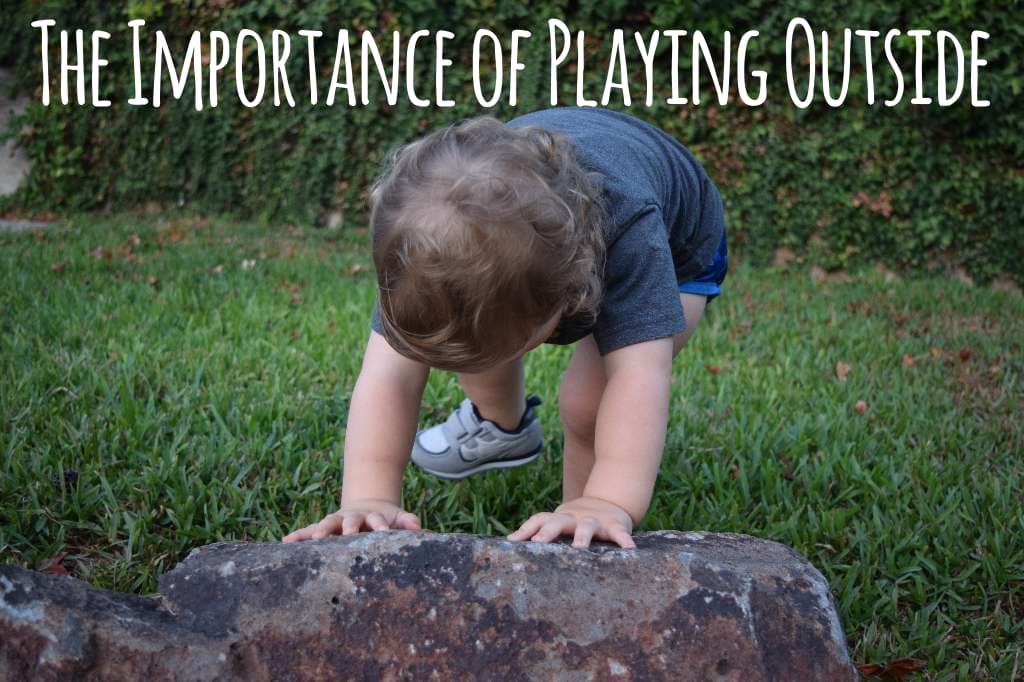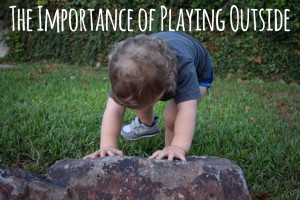I spent my childhood outside. It helped that we lived in a neighborhood that was full of families and children around my age, something that my youngest sister (who was much too young) missed out on. My middle sister and I would meet up with our best friend, a neighbor boy who’s age fell between ours, and embark on daily adventures every day until the sun set. We would ride our bikes around hidden trails, mudslide into a nearby pond, and create elaborate games that would go on for days. We had our greatest triumphs and biggest fights at our neighborhood park. There are few memories more precious than running full speed with my best friend across a field.
Outside is really the perfect place for play. There are no walls to limit full range of movement, no rules on the volume of voices, no boundaries on what to climb, and a good supply of fresh air and natural “toys” like dirt, sticks, rocks, leaves, and pine cones. Sure, there are usually some outside toys around like balls, hula hoops, bikes, and play structures, but having only a few open-ended toys only helps to facilitate the amazing aspects of outdoor play.
There are plenty of great things about indoor play, of course. Indoor play is more about structured, smaller scale play with toys like blocks, puzzles, play kitchens, toy animals, and dress up. It’s also a great place to snuggle up and read. But for many kids, they are just inside too often and for too long. Plus, more and more children are spending hours on end playing video games, having computer time, or watching tv. Too much time in front of a screen is connected to obesity, sensory issues, behavioral problems, and at worst delayed gross motor development. Humans have evolved and developed outdoors, and the new trend to stay indoors has not been a positive leap. Many professionals are using the term “Nature Deficit Disorder” (coined by Richard Louv) to describe the outcomes of children not having enough exposure to nature. These outcomes include a disconnect from the earth and nature, more stress, depression, attention disorders, obesity, and even problems with eye development (as a result of not enough exposure to natural light). The number of kids in all kinds of therapies are sky-rocketing.
So why aren’t children outside more? Unfortunately, there are a number of obstacles that keep kids indoors. The first is that more time sitting at a classroom desk for too much of the day is being required of young children. Kindergarteners are quickly loosing recess time in favor of worksheets and test preparation. Another issue is that adults are suddenly afraid to let kids play with anything that could result in even the smallest of injuries. Schools and daycares are afraid of being sued and parents are afraid of being accused of neglect. And so, when children are allowed to play outside, it is under the close supervision of an adult who reminds them that there is no climbing, sticks, rocks, or throwing. Often, playing indoors and using screen time is a way to avoid the “dangers” of being outside and to give parents a mental break (I totally get it). But is playing outside dangerous? Sometimes. But under normal circumstances (like not playing on a cliff or slippery rocks…) playing outside is safe and will only result and completely normal bumps, cuts, and scratches. Every child will fall and get hurt, but this is a natural part of growing up.
Outdoor play is not just a way to occupy a child’s time, it is essential to their development physically, mentally, and socially.
Playing outside is good for their body:
Having the space to practice throwing, catching, running, jumping, climbing, and tumbling is essential for proper gross (big muscle) motor development. As we humans grow and develop, our vestibular and muscular systems depend on us practicing these body movements. Of course running and moving keep weight and health problems away, but exercise does so much more. For example, walking on uneven ground, especially barefoot, develops the the arches of the feet and strengthens the muscles in ankles and legs. More importantly, it activates reflexes that enable proper heel to toe walking. Each type of movement is developing and nurturing different nerves and muscles. All of the gross motor movement that is happening during outside playtime is creating a significant body awareness that enables children to practice balanced and precise movements that are well coordinated. How well children can hold a pencil or judge physical pressure depends on this development.
The brain is also seeking physical sensory input in order to learn how to process things and develop each of the senses. When a child goes outside, they feel the breeze, the roughness of a branch, the coolness and heaviness of a rock, the delicate crumbles of a leaf, and the damp dirt. They smell the trees and the flowers and the soil. They see greens, browns, reds, yellows, oranges, pinks, and blues in their natural states. They hear the wind, the birds and the rustling of leaves. And some even have the unfortunate experience of tasting a mouthful of dirt. All of these experiences are giving valuable input to the body so that each sense properly develops. It’s no wonder that children that spend their time inside have sensory issues.
Playing outside is good for their minds:
All of the imaginary adventures that children come up with are building important connections within their brain. More outdoor play has been linked to better learning and higher grades. A large reason for this is that children have the opportunity to use up excess energy and let their minds relax. As adults, don’t we feel refreshed and better able to focus after a break? But, the great thing is that learning is actually occurring as they play. They are using hands on learning to gain information on biology, physics, geology, and earth science. They are also practicing skills that will benefit their ability to perform mathematics, problem solving, and critical thinking.
Having time to practice using the imagination during unstructured outside playtime is an incredible way to develop and improve it. Although many games start out as being based on a film or story that they are familiar with, children are constantly coming up with unique ideas that fit with their moods, the time of day/year, and the number of participants.
And, of course, being outside is a strong mood booster and stress reliever. Many, many studies highlight the emotional benefits of even just a short walk outside, around nature. Different types of thinking occur when detached from faster paced thinking that happen when watching television inside. Blood pressure is lowered and the physical action of looking at nature releases pleasure causing hormones. Plus, being physical and acting out games helps children to vent aggression as well as to subconsciously work out emotional problems.
Playing outside is good for their relationships:
There are many different types of play that occur outside. When children play alone, they are fostering independence and relying solely on their own imagination and intellect. This strengthens the sense of self. But even more beneficial, is playing outside with peers.
If children are playing a structured outside game like baseball or dodgeball, they are constantly in cooperation with one another as they follow rules and participate within the structure of the game. They are also learning how to problem solve and diffuse conflict with one another just through the normal hiccups and issues that arise during a game. Imagine a game of baseball. Children create teams, follow rules and procedures, judge one another’s plays, problem solve on questionable calls, and learn how to react to loosing or winning.
Unstructured, “imaginative” play is also incredibly beneficial to a child socially. They are, again, practicing how to cooperate and problem solve with one another. But they are also learning how to share ideas and build knowledge with others. Sitting at a desk, alone with a worksheet, a child must rely completely on their own mind. Outside, in a imagined game or scenario, ideas are shared and learned. And never underestimate the storylines that children come up with, they are often well thought out and very elaborate.
Being outside and playing is the purest and most beneficial thing that children can do. The benefits extend well into adulthood, so pack up the kids and go for a hike or, more simply, check out a local park or hang out in the backyard. The benefits are great and long lasting, but the memories they create will be cherished for a lifetime.








